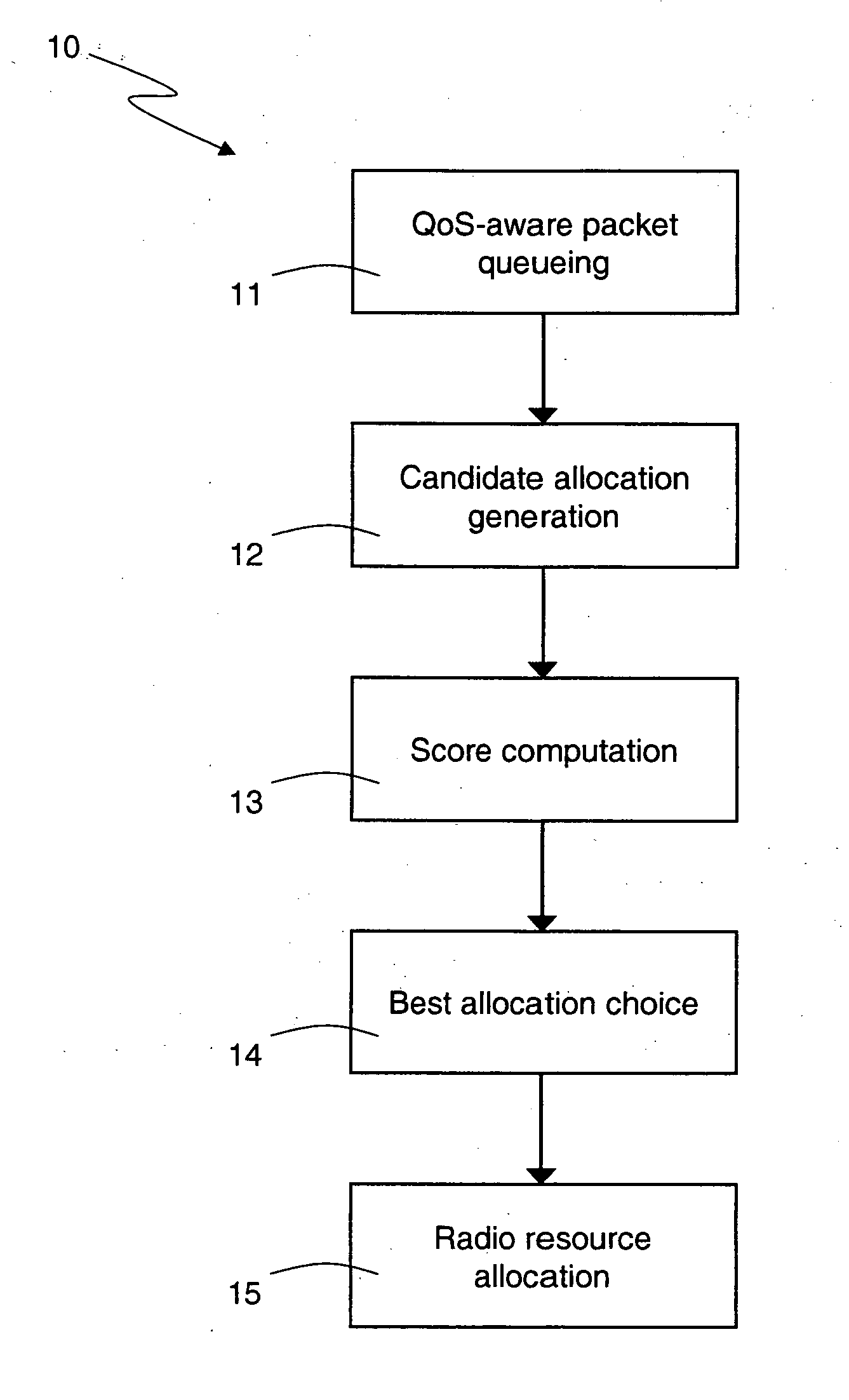Radio resource scheduling for intra-system interference coordination in wireless communication systems
a wireless communication system and radio resource scheduling technology, applied in wireless communication services, wireless commuication services, electrical equipment, etc., can solve the problem of not being able to have in lte a centralized control of interference coordination
- Summary
- Abstract
- Description
- Claims
- Application Information
AI Technical Summary
Benefits of technology
Problems solved by technology
Method used
Image
Examples
first embodiment
[0151]Furthermore, according to the present invention, the scheduler chooses a candidate allocation just looking at a single TTI, and trying to allocate a transmission power on those PRBs particularly sensitive to outbound inter-cell interference in such a way that it is close to the power level assumed by the ICIC mechanism.
[0152]In detail, according to this first embodiment of the present invention, every TTI the scheduler, in the score computation (block 13), computes for each candidate allocation the corresponding scores according to equations (9) or (9′) and (10), and then, in the best allocation choice (block 14), computes for each candidate allocation a corresponding total score that is a sum of the corresponding scores, and chooses one candidate allocation having the best, i.e., the highest, total score.
[0153]In particular, a candidate allocation Γ{tilde over (q)} is chosen directly by the scheduler in a way such as to satisfy the following equation:
q~=argmaxq∑m=1NΩ(m,k,π),(...
second embodiment
[0154]Instead, according to the present invention, the scheduler features a memory of the past TTIs and chooses a candidate allocation such that constraints on average power are fulfilled.
[0155]In detail, according to this second embodiment of the present invention, the scheduler, in the score computation (block 13), has a memory of Λ past TTIs, in the form of Λ allocations {Γq-Λ+1, . . . , Γq} and computes for each candidate allocation the corresponding scores according to equation (9) or (9′) and further according to a different equation (10′) for defining ƒ3.
[0156]In particular, according to this second embodiment of the present invention ƒ3 is defined in the following way:
f3(π)=f3(π_)={c2(1-π_-Ptargetc1)forπ_-Ptarget<(1+kc2)c1-kforπ_-Ptarget≥(1+kc2)c1(10′)where:π_=1Λ∑i=1Λπm,Γq-i+1andwhereπm,Γq-i+1
denotes the transmission power levels used on the m-th PRB in the Λ past TTIs, i.e., in the Λ temporally previous TTIs.
[0157]Then, mutatis mutandis with respect to the first embodime...
third embodiment
[0159]Furthermore, according to the present invention, the scheduler does not only produce allocation for the next TTI, but for multiple future TTIs, i.e., for temporally subsequent TTIs. In this case the scheduler can try to fit the various allocations in a way such that the average power level on those PRBs particularly sensitive to outbound inter-cell interference is kept under control. While the next TTI is being transmitted, the allocation of the temporally subsequent TTIs can be reviewed especially in case the newly reported CQIs are different from the predicted ones during the first planning phase.
[0160]In detail, according to this third embodiment of the present invention, the scheduler decides the allocations of more than one TTI at the same time.
[0161]For example, assuming that the transmission requests already queued are sufficient to fill Λ TTIs, a joint allocation process over the total resources of Λ TTIs can be performed by the scheduler, thus giving a chance to provi...
PUM
 Login to View More
Login to View More Abstract
Description
Claims
Application Information
 Login to View More
Login to View More - R&D
- Intellectual Property
- Life Sciences
- Materials
- Tech Scout
- Unparalleled Data Quality
- Higher Quality Content
- 60% Fewer Hallucinations
Browse by: Latest US Patents, China's latest patents, Technical Efficacy Thesaurus, Application Domain, Technology Topic, Popular Technical Reports.
© 2025 PatSnap. All rights reserved.Legal|Privacy policy|Modern Slavery Act Transparency Statement|Sitemap|About US| Contact US: help@patsnap.com



